|
|
|
Sort Order |
|
|
|
Items / Page
|
|
|
|
|
|
|
| Srl | Item |
| 1 |
ID:
130130
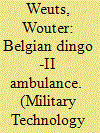

|
|
|
|
|
| Publication |
2013.
|
| Summary/Abstract |
The article evaluates the Belgian DINGO II ambulance from Krauss-Maffei Wegmann (KMW), and discusses its capacities and medical capabilities during its use in the United Nations Interim Force in Lebanon and in the International Security Assistance Force (ISAF) in Afghanistan.
|
|
|
|
|
|
|
|
|
|
|
|
|
|
|
|
| 2 |
ID:
124413
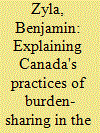

|
|
|
|
|
| Publication |
2013.
|
| Summary/Abstract |
While Canadian burden-sharing practices within NATO in the 1990s are well documented, the data in the literature raise two central questions: (1) was the practice of Canadian burden-sharing a one-time event, or was it part of a larger pattern of practices? and (2) what factors motivated Canada to shoulder the burden to the extent that it did? This article studies the extent of Canada's burden-sharing practices in the context of the International Security Assistance Force (ISAF) mission in Afghanistan. The article makes two arguments: first, Canada's commitment to NATO continued to be strong post-9/11; second, Canada's practices of sharing Atlantic burdens can be explained by its adherence to the norm of "external responsibility," which guided its foreign policy by appealing to Canada's humanitarian responsibilities to contribute at an extraordinary level to the promotion and maintenance of international peace and security.
|
|
|
|
|
|
|
|
|
|
|
|
|
|
|
|
| 3 |
ID:
127829


|
|
|
|
|
| Publication |
2013.
|
| Summary/Abstract |
How are civilian attitudes toward combatants affected by wartime victimization? Are these effects conditional on which combatant inflicted the harm? We investigate the determinants of wartime civilian attitudes towards combatants using a survey experiment across 204 villages in five Pashtun-dominated provinces of Afghanistan-the heart of the Taliban insurgency. We use endorsement experiments to indirectly elicit truthful answers to sensitive questions about support for different combatants. We demonstrate that civilian attitudes are asymmetric in nature. Harm inflicted by the International Security Assistance Force (ISAF) is met with reduced support for ISAF and increased support for the Taliban, but Taliban-inflicted harm does not translate into greater ISAF support. We combine a multistage sampling design with hierarchical modeling to estimate ISAF and Taliban support at the individual, village, and district levels, permitting a more fine-grained analysis of wartime attitudes than previously possible.
|
|
|
|
|
|
|
|
|
|
|
|
|
|
|
|
| 4 |
ID:
134008
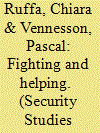

|
|
|
|
|
| Publication |
2014.
|
| Summary/Abstract |
In complex humanitarian emergencies, why are NGO-military relations cooperative in some cases, yet deeply conflictual in others? Drawing on historical-institutionalist theoretical insights, we argue that NGOs and military organizations are embedded in, and responding to, domestic institutional configurations that define a set of political incentives and constraints, material and normative, which structures and influences the characteristics and outcomes of their relations. Counterarguments suggest that organizational differences and the nature of their missions affect NGO-military relations. Using fresh empirical evidence we assess these arguments by comparing the Italian and the French experiences of NGO-military relations during the NATO-led International Security Assistance Force (ISAF) mission in Afghanistan and the UN mission in Lebanon (UNIFIL II) between 2007 and 2011.We find that domestic institutional configurations are not left behind when NGOs and military units deploy abroad. Rather, they shape NGOs' and militaries' capacity to work together instead of at cross purposes and ultimately influence the success of international action.
|
|
|
|
|
|
|
|
|
|
|
|
|
|
|
|
| 5 |
ID:
133163
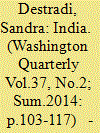

|
|
|
|
|
| Publication |
2014.
|
| Summary/Abstract |
The year 2014 will prove crucial for Afghanistan. The presidential elections will shape the country's political future, both who will govern and how much the process of democratic consolidation will have advanced. On the military front, by the end of the year, the International Security Assistance Force (ISAF) mission is expected to withdraw all combat troops from the country. While the United States and other Western countries are planning to stay engaged in Afghanistan after 2014 through the presence of training and counterterrorism forces, in late 2013 and early 2014 the difficulties in finalizing a Bilateral Security Agreement (BSA) between the United States and Afghan governments led to calls for a "zero option"-a complete departure of all foreign troops from Afghanistan by the end of 2014, leaving the country alone to manage its security, train its armed forces, and fight extremist groups.
|
|
|
|
|
|
|
|
|
|
|
|
|
|
|
|
| 6 |
ID:
128373
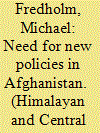

|
|
|
|
|
| Publication |
2011.
|
| Summary/Abstract |
A decade has passed since the defeat of the Taliban government in Afghanistan, and it is hardly surprising that several member-states of the International Security Assistance Force (ISAF) wish to pull out their military forces from Afghanistan, or have already decided to do so. Yet, at first glance not even one of Afghanistaifs multiple problems appears to have been resolved. The Taliban insurgents remain a viable force, and violence regularly occurs throughout the country. The casual observer may well wonder whether the security assistance provided by the international coalition has been of any use at all. Indeed, the ISAF members in many ways appear to have followed contradictory and self-defeating policies in their valiant attempt to remake war-tom Afghanistan into a Western democracy overnight. While not all their efforts have been in vain, more could have been achieved if the realities of Afghanistan had been better understood by those who formulated ISAF policy. The reason for this failure in understanding the Afghan human landscape would seem to depend on two factors: first, an emphasis on do-good policies that included the immediate
introduction of democracy under a strong, central government - which appealed to Western voters but had already been proven futile or outright misguided in almost a century of Afghan attempts at state and nation-
building; second, the lack of a properly focused intelligence effort in Afghanistan, with sufficient resources and the goal to monitor conditions in the country instead of a single-minded focus on targeting in support
of actions against individual terrorists ("the War on Terror"). Or, put in different terms: while Westem military might initially was successfully brought to bear on the Taliban movement, the brain of the military was.
|
|
|
|
|
|
|
|
|
|
|
|
|
|
|
|
|
|
|
|
|